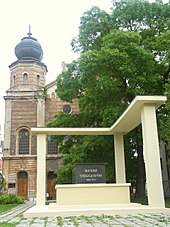Trnava Jewish community
The emergence of the first Jewish community in Trnava (German Tyrnau , Hungarian Nagyszombat, Latin Tyrnavia ), a Slovak city northeast of the capital Bratislava , goes back to the 12th / 13th centuries. Century back. This makes the city of Trnava one of the oldest Jewish settlements in the region. The Jewish families lived in their own neighborhood and were involved in the wine trade and money lending.
history
The Jewish residents were exposed to hostilities from the majority German population. The anti-Jewish sentiment finally led to the expulsion of the Jewish families from the city of Trnava in 1539 under Ferdinand I. The synagogue and the Jewish cemetery were destroyed.
The resettlement of Jewish families took place in the 1780s under Joseph II. After the emperor's death, the population tried again to drive the Jews out of the city.
In the course of the 19th century, the number of Jewish residents increased enormously. In 1831 the initially small community built a synagogue, and around 25 years later a school was established.
At the end of the 1860s, an Orthodox branch split off from the Jewish community and built its own synagogue around 1885 .
In 1891/92 the so-called “majority community” had a new synagogue built according to the plans of the Viennese architect Jakob Gartner .
Zionist organizations were founded around the turn of the century in the community, which continued to grow after 1900 and whose members made a considerable contribution to the city's economic life .
In 1918 anti-Jewish riots broke out in Trnava, during which shops were looted.
Jewish businessmen, among them more than 180 shopkeepers, 60 artisans and 23 factory owners, determined the economic life of the city in the period between the world wars.
In the years immediately after the founding of the Slovak nation state in 1939, anti-Jewish legislation was implemented to the effect that shops and companies were “ Aryanized ” and Jews were obliged to do forced labor.
With the so-called "resettlement" of the Jews from Bratislava , almost 1200 displaced people reached Trnava, so that the Jewish population here increased to more than 3,600 people. In 1942, the Slovak authorities initiated the deportations to the ghettos and extermination camps on Polish soil. In total, more than 80% of the Jews living in Trnava were deported in the course of 1942.
The approximately 600 Jewish residents who remained in the city were also deported by the German occupation authorities in September 1944.
After the end of the Second World War , a new Jewish community was formed in Trnava. It did not exist for long, as most of its relatives emigrated to Israel and other countries by 1949 .
In front of the status quo ante synagogue, a memorial commemorates the victims of the Holocaust .
Community development
| year | Parishioners | in% of the total population |
|---|---|---|
| 1857 | 524 | |
| 1900 | around 1,750 | around 15% of the population |
| 1910 | around 1,800 | |
| 1930 | about 2,700 | including surrounding villages |
| 1941 | about 3,600 | |
| 1944 (March) | circa 630 |
literature
- Klaus-Dieter Alicke: Lexicon of the Jewish communities in the German-speaking area. 3 volumes. Gütersloher Verlagshaus , Gütersloh 2008, ISBN 978-3-579-08035-2 ( online edition )
